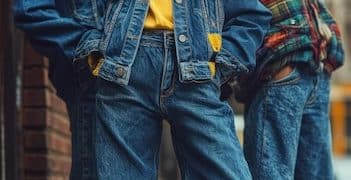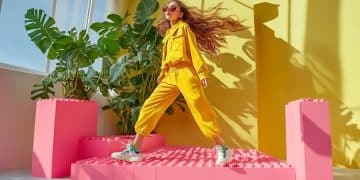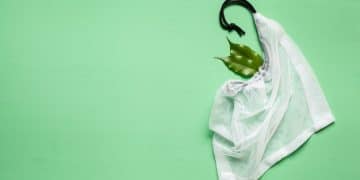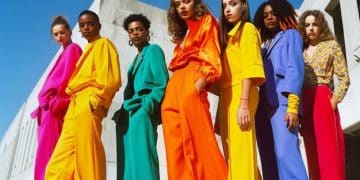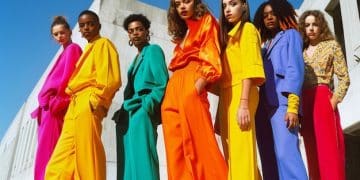Sustainable Fabrics: Shaping Fall 2025 Fashion Trends?

The predicted 12% increase in sustainable fabrics is poised to significantly impact Fall 2025 fashion trends, potentially leading to more eco-conscious designs, innovative materials, and a shift in consumer preferences towards ethically produced clothing.
Will the fashion choices we make in Fall 2025 reflect a greener, more ethical approach? The anticipated surge in sustainable fabric production suggests that will the predicted 12% increase in sustainable fabrics impact Fall 2025 fashion trends?, and the answer is becoming increasingly clear.
Sustainable Fabrics: A Growing Trend in the Fashion Industry
The fashion industry has long been criticized for its environmental impact, but a growing awareness of these issues is driving a shift towards sustainability. This section explores the rising demand for eco-friendly materials and the innovative fabrics that are paving the way for a more responsible fashion future.
The increased availability and affordability of sustainable fabrics are making them more accessible to designers and brands of all sizes. This shift has the potential to transform the fashion landscape, influencing everything from design choices to consumer purchasing decisions.
The Rise of Eco-Consciousness
Consumers are increasingly aware of the environmental and social impact of their purchasing decisions. This awareness is driving demand for sustainable products, including clothing made from eco-friendly materials.
Brands that prioritize sustainability are often seen as more ethical and responsible, which can boost their reputation and attract environmentally conscious customers.
Innovative Sustainable Fabrics
Beyond traditional sustainable materials like organic cotton and recycled polyester, the fashion industry is embracing innovative fabrics made from unexpected sources. These alternative materials offer a more sustainable approach to textile production.
- Pineapple Leaf Fiber (Piñatex): A natural textile made from pineapple leaf waste, offering a vegan alternative to leather.
- Mushroom Leather (Mylo): A bio-based material grown from mycelium, the root structure of mushrooms, providing a sustainable leather alternative.
- Recycled Ocean Plastic (Seaqual): A fabric made from recycled plastic waste recovered from the ocean, helping to clean up marine environments.
These innovative fabrics are not only eco-friendly but also offer unique textures and properties, expanding the creative possibilities for designers.
In conclusion, the growing trend towards sustainable fabrics reflects a fundamental shift in the fashion industry, driven by increased consumer awareness and the development of innovative materials. This trend is likely to have a significant impact on Fall 2025 fashion trends, with designers increasingly incorporating eco-friendly options into their collections.
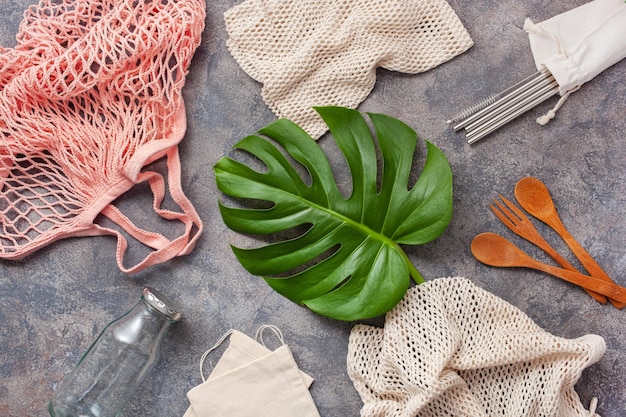
Impact on Fall 2025 Color Palettes and Textures
Considering the rise in sustainable fabrics, it’s reasonable to ask: what impact will this have on the colors and textures we see trending in Fall 2025 collections? This section explores how these fabrics might influence those aesthetic choices.
Sustainable materials often lend themselves to earthy and muted tones, influencing color palettes. Similarly, the textures of innovative fabrics can introduce new dimensions into garment design.
Earthy Tones and Natural Dyes
Many sustainable fabrics are naturally colored or dyed with plant-based dyes, resulting in earthy tones like browns, greens, and muted reds. These colors evoke a sense of nature and sustainability.
The use of natural dyes can also create unique and subtle variations in color, adding depth and character to garments.
Textural Innovations
Innovative sustainable fabrics often have unique textures that can enhance the visual and tactile appeal of clothing. These textures can range from the rough feel of hemp to the smooth finish of Piñatex.
- Raw and Undyed Fabrics: The popularity of raw and undyed fabrics is increasing, showcasing the natural beauty and texture of materials like organic cotton and linen.
- Recycled Materials: Recycled fabrics often have a slightly different texture than virgin materials, which can add a unique touch to garments.
- Innovative Finishes: New finishing techniques are being developed to enhance the texture and drape of sustainable fabrics, making them more versatile for different design applications.
The textures and colors of sustainable fabrics are encouraging designers to experiment with new silhouettes and embellishments, leading to fresh and innovative designs.
In essence, the increased use of sustainable fabrics is expected to influence Fall 2025 fashion trends in terms of color palettes and textures, with earthy tones, natural dyes, and innovative materials playing a significant role in shaping the aesthetic landscape.
How Sustainable Fabrics Influence Design and Silhouettes
The shift towards sustainability is not only affecting fabric choices but also guiding design and silhouette decisions. This section discusses how sustainable materials are shaping the construction and style of Fall 2025 fashion.
Designers are increasingly considering the properties of sustainable fabrics when creating new garments, resulting in innovative designs that maximize the potential of these materials. The drape, weight, and texture of a fabric can all influence silhouette and overall aesthetic.
Minimal Waste Design
Sustainability encourages designers to adopt minimal waste design principles, which aim to reduce fabric waste during the cutting and sewing process.
Techniques like zero-waste pattern cutting and modular design are becoming more popular, resulting in garments that are both stylish and environmentally friendly.
Versatile Silhouettes
Sustainable fabrics often lend themselves to versatile silhouettes that can be easily dressed up or down. These silhouettes are designed to be timeless and adaptable, reducing the need for fast fashion trends.
Classic shapes like A-line skirts, wide-leg pants, and oversized shirts are popular choices for sustainable collections, offering both comfort and style.
Eco-Conscious Embellishments
Designers are also exploring eco-conscious embellishments, such as recycled buttons, natural dyes, and plant-based sequins, to further enhance the sustainability of their designs.
These embellishments add unique details to garments while minimizing their environmental impact.
Ultimately, the adoption of sustainable fabrics is influencing not just the choice of materials, but also the overall design and silhouettes of Fall 2025 fashion, encouraging more thoughtful and eco-friendly approaches to garment construction.

Consumer Demand and Market Trends for Sustainable Fashion
Understanding consumer demand and market trends is crucial for assessing the true impact of sustainable fabrics on Fall 2025 fashion. This section examines current consumer preferences and the evolving market landscape for sustainable clothing.
Consumers are increasingly seeking out brands that align with their values, including sustainability. This demand is driving growth in the sustainable fashion market and influencing the choices of retailers and designers.
Growing Consumer Awareness
Increased media coverage of environmental issues and ethical fashion is raising consumer awareness and driving demand for sustainable products.
Consumers are becoming more informed about the impact of their clothing choices and are actively seeking out brands that prioritize sustainability.
Market Growth and Investment
The sustainable fashion market is experiencing significant growth, with increased investment from both established brands and emerging startups.
This investment is fueling innovation in sustainable materials and production methods, making sustainable fashion more accessible and affordable.
Transparency and Traceability
Consumers are demanding greater transparency and traceability in the fashion supply chain, wanting to know where their clothes come from and how they are made.
Brands are responding by providing more detailed information about their sourcing practices and production processes, building trust with consumers.
- Certifications: Eco-labels and certifications like GOTS (Global Organic Textile Standard) and Oeko-Tex are gaining importance, helping consumers identify sustainable products.
- Second-hand Market: The rise of the second-hand market, including online platforms and consignment stores, offers consumers a way to extend the life cycle of clothing and reduce waste.
- Rental Services: Clothing rental services are becoming more popular, providing consumers with access to a wide range of styles without contributing to overconsumption.
In brief, growing consumer awareness and the overall market trends are fostering increased demand for sustainable fashion, leading to greater availability and innovation in Fall 2025 fashion trends.
Future Projections: The Long-Term Impact of Sustainable Fabrics
Looking ahead, it’s important to consider the potential long-term effects of sustainable fabrics on the fashion industry. This section discusses how these materials might shape the future of fashion beyond Fall 2025.
The continued growth in sustainable fabric production and adoption is likely to lead to significant changes in the fashion industry, promoting more ethical and environmentally responsible practices.
Circular Economy
The fashion industry is increasingly embracing the principles of the circular economy, which aims to minimize waste and maximize the value of resources.
Sustainable fabrics play a key role in the circular economy by enabling the creation of garments that can be easily recycled or repurposed at the end of their life cycle
Technological Innovations
Technological innovations are driving the development of new sustainable fabrics and production methods, making it easier and more affordable for brands to adopt eco-friendly practices.
These innovations include new recycling technologies, bio-based materials, and waterless dyeing techniques.
Policy and Regulation
Government policies and regulations are also playing a role in promoting sustainability in the fashion industry, incentivizing brands to adopt more eco-friendly practices.
These policies include extended producer responsibility schemes, which hold brands accountable for the end-of-life management of their products.
All things considered, the long-term impact of sustainable fabrics on the fashion industry is projected to be significant, promoting more circular, innovative, and ethical practices.
Challenges and Opportunities in Scaling Sustainable Fabric Use
While the move toward sustainable fabrics presents many opportunities, it also comes with challenges. This section discusses the key hurdles and potential solutions for scaling sustainable fabric use across the fashion industry.
To fully realize the potential of sustainable fabrics, the fashion industry must address issues related to cost, availability, and performance, while also fostering collaboration and innovation.
Cost and Affordability
Sustainable fabrics are often more expensive than conventional materials, which can be a barrier for smaller brands and price-sensitive consumers.
To address this challenge, the industry needs to invest in scaling up sustainable fabric production and developing more cost-effective manufacturing processes.
Availability and Supply Chain
The availability of sustainable fabrics can be limited, particularly for niche materials and specialized applications.
Brands need to work closely with suppliers to ensure a reliable and transparent supply chain for sustainable fabrics.
Performance and Durability
Some sustainable fabrics may not perform as well as conventional materials in terms of durability, colorfastness, or wrinkle resistance.
- Investment in Research and Development: More investment is needed in research and development to improve the performance characteristics of sustainable fabrics.
- Collaboration Between Stakeholders: Collaboration between brands, suppliers, and researchers is essential for overcoming these challenges and scaling up sustainable fabric use across the industry.
- Consumer Education: Educating consumers about the benefits of sustainable fabrics and encouraging them to prioritize quality over quantity can help drive demand and support the transition to a more sustainable fashion system.
In conclusion, addressing the challenges related to cost, availability, and performance is crucial for scaling sustainable fabric use and fully transforming the fashion industry.
| Key Point | Brief Description |
|---|---|
| 🌱 Sustainable Fabrics Surge | A 12% projected increase might reshape Fall 2025 fashion. |
| 🎨 Color & Texture Influence | Expect earthy tones and innovative material textures in designs. |
| 🛍️ Consumer Demand | Growing awareness pushes for more ethical fashion choices. |
| 🔄 Circular Economy | Fabrics enabling easier recycling & repurposing in fashion. |
FAQ: Sustainable Fabrics and Fashion Trends
▼
Sustainable fabrics are textiles produced with minimal environmental impact, considering factors like resource use, waste, and social responsibility. They include materials like organic cotton, recycled polyester, and innovative options like Piñatex.
▼
Look for certifications like GOTS, Oeko-Tex, or Bluesign. Check brand websites for detailed information on sourcing and production. Prioritize brands that offer transparency and traceability in their supply chain.
▼
Initially, yes, due to higher production costs. However, as demand and production scale up, prices are becoming more competitive. Consider investing in fewer, higher-quality sustainable pieces for long-term value.
▼
The future looks promising, with ongoing innovations and increasing consumer demand. Expect to see widespread use of sustainable materials, driven by circular economy principles and supportive government policies and regulations.
▼
Make informed purchasing decisions, support sustainable brands, participate in clothing swaps, rent clothes for special occasions, and properly recycle or donate unwanted garments. Every small step counts towards a greener industry.
Conclusion
In conclusion, the projected 12% increase in sustainable fabric usage marks a pivotal shift towards environmentally conscious practices within the fashion industry. As Fall 2025 approaches, we can anticipate collections that not only feature innovative and aesthetically pleasing designs but also embody ethical and responsible production values. The growing integration of sustainable fabrics is poised to revolutionize consumer expectations and drive a new era of creative possibilities.
